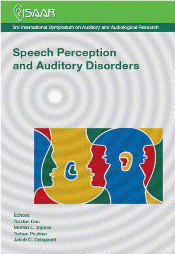Model-based hearing aid gain prescription rule
Abstract
In listeners with sensorineural hearing loss, loudness recruitment is typically observed and can be attributed to a loss or dysfunction of the outer hair cells (OHC). On the level of the basilar membrane (BM), OHC loss results in a reduced gain for low-level signals, changing the BM input-output function. This amount of low-level gain loss cannot be directly estimated from the overall hearing loss as characterized by pure-tone audiometric thresholds. However, from a modelling perspective, a hearing aid might be successful if it is able to compensate the gain loss and thus restore the compressive BM input-output function of a normal-hearing listener. Here, psychoacoustic temporal masking curves (TMC) and adaptive categorical loudness scaling data (ACALOS) of the same normal-hearing (NH) and hearing-impaired (HI) subjects were used to estimate gain loss. A linear model was fitted to predict gain loss from audiometric thresholds and from the steepness of the loudness function. Comparison of the predicted gain loss in HI and the gain in NH lead to a gain prescription rule. This prescription was tested with a conventional hearing-aid compressor and a model-based version, which compares simple NH and HI auditory models in real time.
References
Chalupper, J., Fastl, H. (2002). “Dynamic loudness model (DLM) for normal and hearing-impaired listeners” Acta Acustica United with Acustica 88, 378-386.
Dillon, H. (2001) Hearing Aids, Thieme Medical Publishers, New York, NY, USA Grimm, G., Herzke, T., Berg, D., and Hohmann, V. (2006). “The Master Hearing Aid - a PC-based platform for algorithm development and evaluation. Acustica - acta acustica” , 92, 618-628
Herzke, T., and Hohmann, V. (2005). “Effects of instantaneous multi-band dynamic compression on speech intelligibility” EURASIP Journal on Applied Signal Processing, 18, 3034-3043
Hohmann, V., and Kollmeier, B. (2007). “A nonlinear auditory filterbank controlled by sub-band instantaneous frequency estimates” in B. Kollmeier, G. Klump, V. Hohmann, U. Langemann, M. Mauermann, S. Uppenkamp, and J. Verhey, editors, Hearing: from sensory processing to perception - 14th International Symposium on Hearing , pages 11-18. Springer, Berlin.
Jepsen, M.L., Dau, T., (2011). “Characterizing auditory processing and perception in individual listeners with sensorineural hearing loss,” J. Acoust. Soc. Am. 129, 262-281.
Jürgens, T., Kollmeier, B., Brand, T., and Ewert, S. D. (2011). “Assessment of auditory nonlinearity for listeners with different hearing losses using temporal masking and categorical loudness scaling” Hearing Research, in Press, [doi:10.1016/j.heares.2011.05.016]
Lopez-Poveda, E. A., Plack, C. J., and Meddis, R. (2003). “Cochlear nonlinearity between 500 and 8000 Hz in listeners with normal hearing” J. Acoust. Soc. Am. 113, 951–960.
Nelson, D.A., Schroder, A.C., Wojtczak, M. (2001). “A new procedure for measuring peripheral compression in normal-hearing and hearing-impaired listeners” J. Acoust. Soc. Am. 110, 2045-2064.
Plack, C. J., and Oxenham, A. J. (2000). “Basilar-membrane nonlinearity estimated by pulsation threshold” J. Acoust. Soc. Am. 107, 501–507.
Plack, C.J., Drga, V., Lopez-Poveda, E.A (2004). “Inferred basilar-membrane response functions for listeners with mild to moderate sensorineural hearing loss” J. Acoust. Soc. Am. 115, 1684-1695.
Wagener, K., and Brand, T. (2005). “Sentence intelligibility in noise for listeners with normal hearing and hearing impairment: influence of measurement procedure and masking parameters”, International Journal of Audiology, 44, 144-156
Wesker, T., Meyer, B., Wagener, K., Anemüller, J., Mertins, A., and Kollmeier, B. (2005). “Oldenburg logatome speech corpus (ollo) for speech recognition experiments with humans and machines” In Proceedings of Interspeech, pp. 1273-1276, Lisbon, Portugal
Additional Files
Published
How to Cite
Issue
Section
License
Authors who publish with this journal agree to the following terms:
a. Authors retain copyright* and grant the journal right of first publication with the work simultaneously licensed under a Creative Commons Attribution License that allows others to share the work with an acknowledgement of the work's authorship and initial publication in this journal.
b. Authors are able to enter into separate, additional contractual arrangements for the non-exclusive distribution of the journal's published version of the work (e.g., post it to an institutional repository or publish it in a book), with an acknowledgement of its initial publication in this journal.
c. Authors are permitted and encouraged to post their work online (e.g., in institutional repositories or on their website) prior to and during the submission process, as it can lead to productive exchanges, as well as earlier and greater citation of published work (See The Effect of Open Access).
*From the 2017 issue onward. The Danavox Jubilee Foundation owns the copyright of all articles published in the 1969-2015 issues. However, authors are still allowed to share the work with an acknowledgement of the work's authorship and initial publication in this journal.


